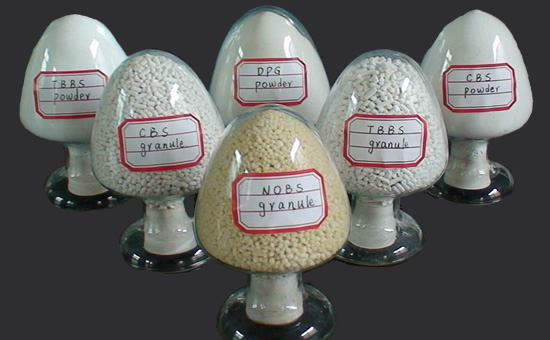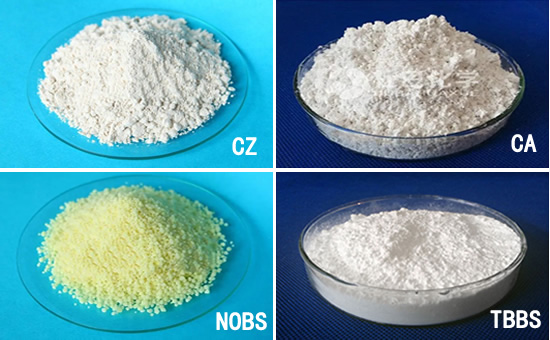
Rubber accelerator can accelerate vulcanization to shorten the vulcanization time and improve production efficiency. It can also stabilize the rubber molecular chain to enhance the mechanical strength of vulcanized compounds, improve the elongation at break of vulcanized rubber, and improve the effect of rubber mixing and plasticization. As a kind of rubber, regenerated rubber uses the same type of accelerator as the original rubber. You can choose a suitable rubber accelerator according to the type of regenerated rubber; it should be noted that the amount of accelerator used in regenerated rubber is less than that of original rubber, otherwise Easy to cause scorching. Accelerators commonly used in rubber can be divided into thiazoles, thiurams, sulfenamides, guanidines, dithiocarbamates, aldehydes, amines, xanthates and thioureas according to different chemical structures. Eight categories. :
Vulcanization accelerator: the main function is to promote the vulcanization reaction of regenerated rubber, and accelerate the vulcanization speed and efficiency. The following types are commonly used:
TMTD (Tetramethylthiosulfuramide): Suitable for natural reclaimed rubber, butyl reclaimed rubber, neoprene reclaimed rubber, nitrile reclaimed rubber, etc.
TBBS (N-tert-butyl-2-benzoimide): suitable for butyl reclaimed rubber, neoprene reclaimed rubber, nitrile reclaimed rubber, etc.
CBS (N-cyclopentyl-2-benzoimide): suitable for natural reclaimed rubber, butyl reclaimed rubber, neoprene reclaimed rubber, nitrile reclaimed rubber, etc.
MBTS (diphenyl-2-butyl thiosulfate): suitable for natural reclaimed rubber, YY230531 butyl reclaimed rubber, neoprene reclaimed rubber, nitrile reclaimed rubber, etc.
Vulcanization accelerator M: suitable for natural reclaimed rubber, butyl regenerated rubber, neoprene regenerated rubber, nitrile butadiene regenerated rubber, etc.
Vulcanization accelerator DM: suitable for butyl reclaimed rubber, neoprene regenerated rubber, nitrile butadiene regenerated rubber, styrene-butadiene regenerated rubber, etc.
Vulcanization accelerator PZ: suitable for natural reclaimed rubber, butyl regenerated rubber, neoprene regenerated rubber, nitrile butadiene regenerated rubber, etc.
Vulcanization accelerator CZ: suitable for natural reclaimed rubber, butyl regenerated rubber, neoprene regenerated rubber, nitrile regenerated rubber, etc.
Vulcanization retarder: The main function is to delay the vulcanization reaction of recycled rubber. The following types are commonly used:
TMTM (Tetramethylthioimidazole): Suitable for natural reclaimed rubber, butyl reclaimed rubber, neoprene reclaimed rubber, etc.
PVI (N-isobutyl-2-benzoimide): suitable for natural reclaimed rubber, butyl reclaimed rubber, neoprene reclaimed rubber, nitrile reclaimed rubber, etc.

Crosslinking agent: the main function is to enhance the physical properties and heat resistance of recycled rubber. The following types are commonly used:
TAIC (Triisocyanate): Suitable for butyl reclaimed rubber, neoprene reclaimed rubber, nitrile reclaimed rubber, etc.
BIPB (Bisumene Peroxide): suitable for butyl reclaimed rubber, neoprene reclaimed rubber, nitrile reclaimed rubber, etc.
Processing aids: the main function is to improve the processing performance and physical properties of recycled rubber. The following types are commonly used:
A (fatty acid): Suitable for natural reclaimed rubber, butyl reclaimed rubber, neoprene reclaimed rubber, etc.
D (styrene-butadiene copolymer): suitable for butyl reclaimed rubber, neoprene reclaimed rubber, nitrile reclaimed rubber, etc.
The main function of the accelerator is to accelerate the vulcanization reaction. The accelerator can also accelerate the vulcanization reaction at room temperature, while the auxiliary agent plays an auxiliary role, which can improve the performance of the sulfide and increase the vulcanization cross-linking density. In rubber processing, suitable accelerators, accelerators and auxiliary agents can be selected according to rubber types and requirements to produce rubber products with excellent performance. The amount and ratio of rubber accelerators also need to be adjusted according to the specific situation. Excessive use or improper ratio may have a negative impact on the performance of rubber. When using rubber accelerators, it is necessary to strictly follow the production process and formula requirements to ensure the quality and performance of rubber products.
Exclusive original article [commercial authorization] reprint, excerpt and excerpt in any form are prohibited without written authorization. Focus on Hongyun rubber: learn the process formula and raw material technology of producing rubber products from recycled rubber to help you reduce costs and increase profits